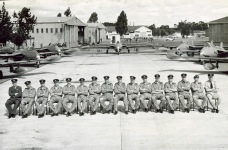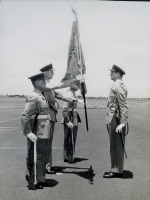60th Anniversary – A Brief Disbandment
The squadron had only recently started to operate the  Hunter and moved from the UK to Cyprus when news was received in January 1959 that it was to disband at the end of March. The one piece of good news was that the squadron’s number plate, along with the standard, silver and long tradition of service in the Middle East, was to be handed over to the present 142 Squadron based at RAF Eastleigh in Kenya, thus continuing the squadron’s thirty-nine years unbroken service in the region. On 26 March the squadron paraded for the last time before the Commander-in-Chief, Middle East Air Force, Air Marshal Sir William MacDonald KCB, CBE, DFC. A flypast and aerobatic display followed, signalling the end of the squadron’s brief stay in Cyprus operating the Hunter. Three days later, the commanding officer, Squadron Leader John Granville-White, left for Eastleigh accompanied by four officers and eleven airmen, for the ceremonial handing over of the squadron standard and silver to the new 208 Squadron. No. 142 Squadron had only recently been reformed with Venom FB 4s under the command of Squadron Leader R. Ramirez. By a strange coincidence there was a remarkable similarity between the two squadron crests, 208 having a Sphinx portrayed from the front and 142 having a winged Sphinx sideways on.
Hunter and moved from the UK to Cyprus when news was received in January 1959 that it was to disband at the end of March. The one piece of good news was that the squadron’s number plate, along with the standard, silver and long tradition of service in the Middle East, was to be handed over to the present 142 Squadron based at RAF Eastleigh in Kenya, thus continuing the squadron’s thirty-nine years unbroken service in the region. On 26 March the squadron paraded for the last time before the Commander-in-Chief, Middle East Air Force, Air Marshal Sir William MacDonald KCB, CBE, DFC. A flypast and aerobatic display followed, signalling the end of the squadron’s brief stay in Cyprus operating the Hunter. Three days later, the commanding officer, Squadron Leader John Granville-White, left for Eastleigh accompanied by four officers and eleven airmen, for the ceremonial handing over of the squadron standard and silver to the new 208 Squadron. No. 142 Squadron had only recently been reformed with Venom FB 4s under the command of Squadron Leader R. Ramirez. By a strange coincidence there was a remarkable similarity between the two squadron crests, 208 having a Sphinx portrayed from the front and 142 having a winged Sphinx sideways on.
On 1 April  1959 a short and impressive hand-over ceremony took place in the presence of His Excellency the Governor and Lady Baring and other VIPs. These included two former squadron commanders, Air Vice-Marshal H.G. Smart CBE, DFC, AFC and Air Commodore H.M. Probyn CB, DSO, OBE. Flying Officer P.G. Biddiscombe received the squadron standard from Flying Officer R.M.J. David of the retiring squadron standard party. With nine Venoms and two Vampire T.11s, the squadron was soon in full training. With an APC scheduled at Thornhill in Southern Rhodesia, emphasis was placed on simulated air-to-ground rocket sightings in the low flying area in the Rift Valley. The squadron left for Rhodesia in June and, after a very successful APC, a tour of Rhodesia and Nyasaland was undertaken. The squadron had barely had time to settle back at Eastleigh when six aircraft and a large support party left for Khormaksar en-route to Sharjah to participate in a large-scale exercise. The mobility for which the squadron had become justifiably renowned over previous decades was, once again, a feature of the squadron’s operations and would remain so for the next decade.
1959 a short and impressive hand-over ceremony took place in the presence of His Excellency the Governor and Lady Baring and other VIPs. These included two former squadron commanders, Air Vice-Marshal H.G. Smart CBE, DFC, AFC and Air Commodore H.M. Probyn CB, DSO, OBE. Flying Officer P.G. Biddiscombe received the squadron standard from Flying Officer R.M.J. David of the retiring squadron standard party. With nine Venoms and two Vampire T.11s, the squadron was soon in full training. With an APC scheduled at Thornhill in Southern Rhodesia, emphasis was placed on simulated air-to-ground rocket sightings in the low flying area in the Rift Valley. The squadron left for Rhodesia in June and, after a very successful APC, a tour of Rhodesia and Nyasaland was undertaken. The squadron had barely had time to settle back at Eastleigh when six aircraft and a large support party left for Khormaksar en-route to Sharjah to participate in a large-scale exercise. The mobility for which the squadron had become justifiably renowned over previous decades was, once again, a feature of the squadron’s operations and would remain so for the next decade.
The squadron commander formed an aerobatic team with Flight Lieutenants G.E. Ord, S.W.R.A. Key, P.R.E. McLeland and Flying Officer T.E. Riddihough. On 25 August they left for Dar-es-Salaam to participate in the celebrations for the Sultan of Zanzibar’s 80th birthday. The team were in action again in December when they left for Entebbe and had barely returned when six aircraft of ‘A’ Flight left for Bahrain via Khormaksar and Sharjah on 4 January 1960. The detachment lasted for twelve weeks, with ‘B’ Flight completing the second six-week period. These long transit sorties were flown with rudimentary navigation aids and to the limit of fuel endurance. The serviceability achieved was a credit to the ground crew. With the return of ‘B’ Flight in mid-March 1960, the squadron left for RAF Stradishall in Suffolk to convert to the Hunter FGA. 9 and another new era was about to begin.
Graham Pitchfork , Naval 8 - 208 Sqn Association Historian
 Hunter and moved from the UK to Cyprus when news was received in January 1959 that it was to disband at the end of March. The one piece of good news was that the squadron’s number plate, along with the standard, silver and long tradition of service in the Middle East, was to be handed over to the present 142 Squadron based at RAF Eastleigh in Kenya, thus continuing the squadron’s thirty-
Hunter and moved from the UK to Cyprus when news was received in January 1959 that it was to disband at the end of March. The one piece of good news was that the squadron’s number plate, along with the standard, silver and long tradition of service in the Middle East, was to be handed over to the present 142 Squadron based at RAF Eastleigh in Kenya, thus continuing the squadron’s thirty- 1959 a short and impressive hand-
1959 a short and impressive hand-




